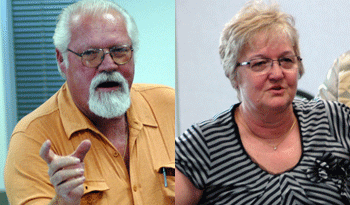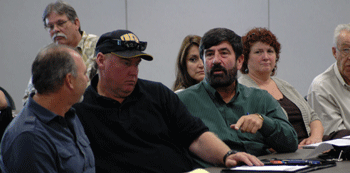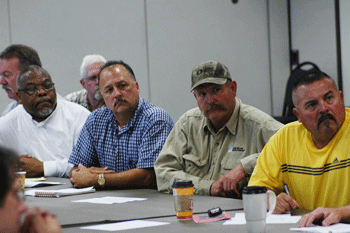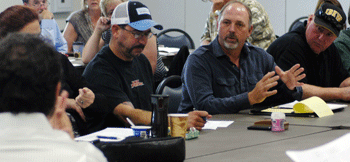PG&E has a problem. Could Nick Stavropoulos be the solution?
The problem is the company’s beleaguered gas delivery system. Stavropoulos is the guy who has shouldered the responsibility for getting it fixed.
“I have been brought in here to head the change we need to make in the gas business,” said Stavropoulos, a plain-talking 30-year industry veteran from the East Coast hired by PG&E in May. “I know it’s got to get done and I’m here to see we get it done.”
He didn’t hide those words in a quick-to-be-forgotten corporate press release. He said it at union headquarters on Sept. 29 to people with very long memories—about two dozen IBEW gas employees, stewards, and bargaining committee members.
The more Stavropoulos talked, the closer they listened.
Stavropoulos had blunt words about the management culture that allowed PG&E’s problems to fester. But he cautioned that the company didn’t have the resources to fix all of its problems at once.
What PG&E needs, he said, is “a smart, effective integrity management system” that identifies the areas of highest risk to the gas system. That assessment has to be performed, no matter how many inspections it might take.
“If we have to do a thousand inspections, we’re going to do a thousand inspections,” he said.
Stavropoulos didn’t bring a Power Point presentation or a packet of glossy
color handouts to the union meeting. To illustrate what he meant by effective integrity management he stepped over to the white board and drew an iceberg, representing the gas work that needed to be done. One approach would be to shave off the work that doesn’t fit into the budget and hope that those problems will somehow just drift away.
But problems don’t drift away, he said. They sink down and attach to the part of the iceberg that is below the water line, out of sight. You haven’t solved the problem, you’ve simply hidden it.
Effective integrity management , Stavropoulos said, means that problems must be identified and prioritized. If some problems have to be rolled over into the next year, they must be tracked and dealt with—not forgotten.
“Do the people above you buy into this?” asked one union member, like he couldn’t quite believe what he was hearing.
You can’t blame union members for being skeptical. They have fresh memories of high-priced consultants who knew more about pinching pennies than fixing gas lines.
Stavropoulos didn’t waste a lot of breath trying to convince the union members of his sincerity.
“My words are cheap,” he said. “You’ve got to judge me by my actions.”
Will do, a lot of faces around the table seemed to be saying.
A Hands-On Gas Guy
Stavropoulos doesn’t come from the world of high finance. His mother, he said, was an IBEW member for 41 years. He studied accounting in college and as a young man was involved in rate cases for the Colonial Gas Co. in Massachusetts. Early on he found that accounting was not a good match for his personality and he moved into operations.
At Boston Gas he was head of gas supply planning for all of New England, and eventually became chief operating officer for National Grid Gas, responsible for gas operations throughout the northeastern United States.
By his own account, he’s always been a hands-on guy.
“I love this business,” he told the IBEW members in Vacaville. “I love visiting crews, seeing what’s going on.”
When he arrived at PG&E he climbed into a gas truck and started looking for the computer. There wasn’t one.
“We are 15 years behind the times here” in terms of processes and technology, he said.
No one at the table in Vacaville argued the point. Nor did anyone seem to disagree when he said employees had to be included in the process if the company hoped to identify ways to do things smarter and more efficiently.
At this point, Local 1245 Business Manager Tom Dalzell jumped into the conversation.
“What we’re seeing here is the opposite of Accenture,” said Dalzell, referring to the consulting firm that guided PG&E’s disastrous experiment with Business Transformation some years back. Dalzell noted that Accenture spent a year designing new work processes without ever talking to the employees who actually perform the work.
“I don’t hire consultants,” Stavropoulos said. “I don’t need to hire management consultants. They pay me to be the manager, why hire somebody else with less experience?”
That declaration was greeted with a burst of applause.
“A Lot of Changes”
Stavropoulos said the company had committed $2.2 billion over the next four years to tackle problems in its gas transmission system. He acknowledged there were serious challenges in gas distribution as well, but again cautioned that the problems wouldn’t be solved overnight.
“We’re going to have Aldyl-A pipe for a long time,” he said, referring to a type of plastic pipe that is prone to cracking and was implicated in a recent gas explosion at a residence in Cupertino. “We have to understand the performance characteristics of Aldyl-A where we have it. Some Aldyl-A may be performing better than others—we have to prioritize.”

Jim Findley, left, and Peggy Daniel, right, speak up at the meeting with Nick Stavropoulos. Findley sounded an early warning about the dangers of Aldyl-A pipe at PG&E Shareholder meetings in recent years. Daniel represents PG&E Pipeline Operations on the Local 1245 Advisory Council.
He said that employees were “going to see a lot of changes when it comes to inspection of pipe.”
Even with an aggressive program of inspection and replacement, it is not possible to prevent all gas leaks. How effectively a utility responds is critical. Gas leaks frighten customers, and a slow response angers them.
Stavropoulos said his goal was to have 99% of all gas leaks responded to within an hour.
If Stavropoulos intended to engage the union members in a conversation, he succeeded. Several business representatives and shop stewards jumped in with suggestions on how processes could be improved or issues that needed addressing. Stavropoulos listened carefully, occasionally scribbling a note to himself.
Elephant in the Room
The elephant in the room when it comes to service safety and reliability is staffing. It takes boots on the ground to replace aging infrastructure and to respond to gas leaks in a timely fashion. Although there has been a recent uptick in hiring, PG&E’s gas workforce is only about half the size it was 25 years ago.
Efficiency measures can only take you so far if you don’t have the bodies to get the work done.
Stavropoulos didn’t specify what size workforce would be needed to carry out his ambitious program to improve the safety and reliability of PG&E’s gas service. But he acknowledged that 50% of PG&E’s gas distribution workers will become eligible for retirement over the next five years. Of all the challenges PG&E faces in providing safe and reliable gas service, this demographic time bomb may be the biggest of all.
In a news release last May announcing that it was hiring Stavropoulos, PG&E said, “Nick is being given the authority and access to company resources to achieve our turnaround goals.”
Will that “authority and access to company resources” include the authority to beef up PG&E’s shrunken workforce?
The answer to that question will probably be the most important factor in determining whether Nick Stavropoulos can truly “head the change” that PG&E needs to make.




